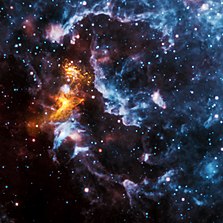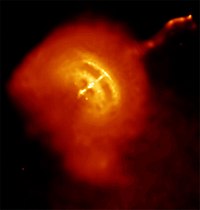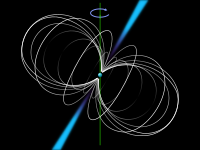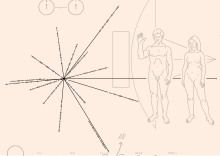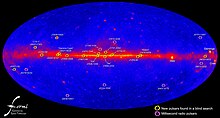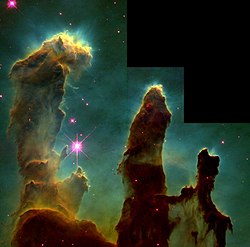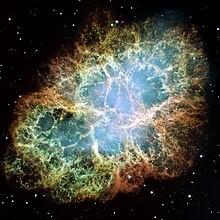PSR B1509-58 – X-rays from Chandra are gold; Infrared from WISE in red, green and blue/max.
A pulsar (from pulse and -ar as in quasar) is a highly magnetized rotating neutron star that emits a beam of electromagnetic radiation. This radiation can be observed only when the beam of emission is pointing toward Earth (much like the way a lighthouse
can be seen only when the light is pointed in the direction of an
observer), and is responsible for the pulsed appearance of emission.
Neutron stars are very dense, and have short, regular rotational periods.
This produces a very precise interval between pulses that ranges from
milliseconds to seconds for an individual pulsar. Pulsars are believed
to be one of the candidates for the source of ultra-high-energy cosmic rays (see also centrifugal mechanism of acceleration).
The periods of pulsars make them very useful tools. Observations of a pulsar in a binary neutron star system were used to indirectly confirm the existence of gravitational radiation. The first extrasolar planets were discovered around a pulsar, PSR B1257+12. Certain types of pulsars rival atomic clocks in their accuracy in keeping time.
History of observation
Discovery
Chart on which Jocelyn Bell Burnell first recognised evidence of a pulsar, exhibited at Cambridge university Library
Composite optical/X-ray image of the Crab Nebula, showing synchrotron emission in the surrounding pulsar wind nebula, powered by injection of magnetic fields and particles from the central pulsar.
The first pulsar was observed on November 28, 1967, by Jocelyn Bell Burnell and Antony Hewish. They observed pulses separated by 1.33 seconds that originated from the same location in the sky, and kept to sidereal time.
In looking for explanations for the pulses, the short period of the
pulses eliminated most astrophysical sources of radiation, such as stars, and since the pulses followed sidereal time, it could not be man-made radio frequency interference.
When observations with another telescope confirmed the emission,
it eliminated any sort of instrumental effects. At this point, Bell
Burnell said of herself and Hewish that "we did not really believe that
we had picked up signals from another civilization, but obviously the
idea had crossed our minds and we had no proof that it was an entirely
natural radio emission. It is an interesting problem—if one thinks one
may have detected life elsewhere in the universe, how does one announce
the results responsibly?" Even so, they nicknamed the signal LGM-1, for "little green men" (a playful name for intelligent beings of extraterrestrial origin).
It was not until a second pulsating source was discovered in a
different part of the sky that the "LGM hypothesis" was entirely
abandoned. Their pulsar was later dubbed CP 1919, and is now known by a number of designators including PSR 1919+21 and PSR J1921+2153. Although CP 1919 emits in radio wavelengths, pulsars have subsequently been found to emit in visible light, X-ray, and gamma ray wavelengths.
The word "pulsar" is a portmanteau of 'pulsating' and 'quasar', and first appeared in print in 1968:
| “ | An entirely novel kind of star came to light on Aug. 6 last year and was referred to, by astronomers, as LGM (Little Green Men). Now it is thought to be a novel type between a white dwarf and a neutron [star]. The name Pulsar is likely to be given to it. Dr. A. Hewish told me yesterday: "… I am sure that today every radio telescope is looking at the Pulsars." | ” |
The existence of neutron stars was first proposed by Walter Baade and Fritz Zwicky in 1934, when they argued that a small, dense star consisting primarily of neutrons would result from a supernova. Based on the idea of magnetic flux conservation from magnetic main sequence stars, Lodewijk Woltjer proposed in 1964 that such neutron stars might contain magnetic fields as large as 10^14 to 10^16 G. In 1967, shortly before the discovery of pulsars, Franco Pacini
suggested that a rotating neutron star with a magnetic field would emit
radiation, and even noted that such energy could be pumped into a supernova remnant around a neutron star, such as the Crab Nebula. After the discovery of the first pulsar, Thomas Gold
independently suggested a rotating neutron star model similar to that
of Pacini, and explicitly argued that this model could explain the
pulsed radiation observed by Bell Burnell and Hewish. The discovery of the Crab pulsar later in 1968 seemed to provide confirmation of the rotating neutron star model of pulsars. The Crab pulsar has a 33-millisecond
pulse period, which was too short to be consistent with other proposed
models for pulsar emission. Moreover, the Crab pulsar is so named
because it is located at the center of the Crab Nebula, consistent with
the 1933 prediction of Baade and Zwicky.
In 1974, Antony Hewish and Martin Ryle became the first astronomers to be awarded the Nobel Prize in Physics, with the Royal Swedish Academy of Sciences noting that Hewish played a "decisive role in the discovery of pulsars".
Considerable controversy is associated with the fact that Hewish was
awarded the prize while Bell, who made the initial discovery while she
was his PhD student, was not. Bell claims no bitterness upon this point,
supporting the decision of the Nobel prize committee.
Milestones
The Vela Pulsar and its surrounding pulsar wind nebula.
In 1974, Joseph Hooton Taylor, Jr. and Russell Hulse discovered for the first time a pulsar in a binary system, PSR B1913+16. This pulsar orbits another neutron star with an orbital period of just eight hours. Einstein's theory of general relativity predicts that this system should emit strong gravitational radiation, causing the orbit to continually contract as it loses orbital energy.
Observations of the pulsar soon confirmed this prediction, providing
the first ever evidence of the existence of gravitational waves. As of
2010, observations of this pulsar continue to agree with general
relativity. In 1993, the Nobel Prize in Physics was awarded to Taylor and Hulse for the discovery of this pulsar.
In 1982, Don Backer led a group which discovered PSR B1937+21, a pulsar with a rotation period of just 1.6 milliseconds (38,500 rpm).
Observations soon revealed that its magnetic field was much weaker than
ordinary pulsars, while further discoveries cemented the idea that a
new class of object, the "millisecond pulsars" (MSPs) had been found. MSPs are believed to be the end product of X-ray binaries. Owing to their extraordinarily rapid and stable rotation, MSPs can be used by astronomers as clocks rivaling the stability of the best atomic clocks on Earth. Factors affecting the arrival time of pulses at Earth by more than a few hundred nanoseconds
can be easily detected and used to make precise measurements. Physical
parameters accessible through pulsar timing include the 3D position of
the pulsar, its proper motion, the electron content of the interstellar medium
along the propagation path, the orbital parameters of any binary
companion, the pulsar rotation period and its evolution with time.
(These are computed from the raw timing data by Tempo,
a computer program specialized for this task.) After these factors have
been taken into account, deviations between the observed arrival times
and predictions made using these parameters can be found and attributed
to one of three possibilities: intrinsic variations in the spin period
of the pulsar, errors in the realization of Terrestrial Time
against which arrival times were measured, or the presence of
background gravitational waves. Scientists are currently attempting to
resolve these possibilities by comparing the deviations seen between
several different pulsars, forming what is known as a pulsar timing array. The goal of these efforts is to develop a pulsar-based time standard precise enough to make the first ever direct detection of gravitational waves.
In June 2006, the astronomer John Middleditch and his team at LANL announced the first prediction of pulsar glitches with observational data from the Rossi X-ray Timing Explorer. They used observations of the pulsar PSR J0537-6910.
In 1992, Aleksander Wolszczan discovered the first extrasolar planets around PSR B1257+12. This discovery presented important evidence concerning the widespread existence of planets outside the Solar System, although it is very unlikely that any life form could survive in the environment of intense radiation near a pulsar.
In 2016, AR Scorpii was identified as the first pulsar in which the compact object is a white dwarf instead of a neutron star.
Because its moment of inertia is much higher than that of a neutron
star, the white dwarf in this system rotates once every 1.97 minutes,
far slower than neutron-star pulsars.
The system displays strong pulsations from ultraviolet to radio
wavelengths, powered by the spin-down of the strongly magnetized white
dwarf.
Nomenclature
Initially pulsars were named with letters of the discovering observatory followed by their right ascension
(e.g. CP 1919). As more pulsars were discovered, the letter code became
unwieldy, and so the convention then arose of using the letters PSR
(Pulsating Source of Radio) followed by the pulsar's right ascension and
degrees of declination
(e.g. PSR 0531+21) and sometimes declination to a tenth of a degree
(e.g. PSR 1913+16.7). Pulsars appearing very close together sometimes
have letters appended (e.g. PSR 0021-72C and PSR 0021-72D).
The modern convention prefixes the older numbers with a B (e.g.
PSR B1919+21), with the B meaning the coordinates are for the 1950.0
epoch. All new pulsars have a J indicating 2000.0 coordinates and also
have declination including minutes (e.g. PSR J1921+2153). Pulsars that
were discovered before 1993 tend to retain their B names rather than use
their J names (e.g. PSR J1921+2153 is more commonly known as PSR
B1919+21). Recently discovered pulsars only have a J name (e.g. PSR J0437-4715). All pulsars have a J name that provides more precise coordinates of its location in the sky.
Formation, mechanism, turn off
Schematic
view of a pulsar. The sphere in the middle represents the neutron star,
the curves indicate the magnetic field lines, the protruding cones
represent the emission beams and the green line represents the axis on
which the star rotates.
The events leading to the formation of a pulsar begin when the core of a massive star is compressed during a supernova, which collapses into a neutron star. The neutron star retains most of its angular momentum, and since it has only a tiny fraction of its progenitor's radius (and therefore its moment of inertia is sharply reduced), it is formed with very high rotation speed. A beam of radiation
is emitted along the magnetic axis of the pulsar, which spins along
with the rotation of the neutron star. The magnetic axis of the pulsar
determines the direction of the electromagnetic beam, with the magnetic
axis not necessarily being the same as its rotational axis. This
misalignment causes the beam to be seen once for every rotation of the
neutron star, which leads to the "pulsed" nature of its appearance.
In rotation-powered pulsars, the beam originates from the rotational energy
of the neutron star, which generates an electrical field from the
movement of the very strong magnetic field, resulting in the
acceleration of protons and electrons on the star surface and the
creation of an electromagnetic beam emanating from the poles of the
magnetic field. This rotation slows down over time as electromagnetic
power is emitted. When a pulsar's spin period slows down sufficiently,
the radio pulsar mechanism is believed to turn off (the so-called
"death line"). This turn-off seems to take place after about
10–100 million years, which means of all the neutron stars born in the
13.6 billion year age of the universe, around 99% no longer pulsate.
Though the general picture of pulsars as rapidly rotating neutron stars is widely accepted, Werner Becker of the Max Planck Institute for Extraterrestrial Physics said in 2006, "The theory of how pulsars emit their radiation is still in its infancy, even after nearly forty years of work."
Categories
Three distinct classes of pulsars are currently known to astronomers, according to the source of the power of the electromagnetic radiation:
- Rotation-powered pulsars, where the loss of rotational energy of the star provides the power,
- Accretion-powered pulsars (accounting for most but not all X-ray pulsars), where the gravitational potential energy of accreted matter is the power source (producing X-rays that are observable from the Earth).
- Magnetars, where the decay of an extremely strong magnetic field provides the electromagnetic power.
Although all three classes of objects are neutron stars, their
observable behavior and the underlying physics are quite different.
There are, however, connections. For example, X-ray pulsars
are probably old rotationally-powered pulsars that have already lost
most of their power, and have only become visible again after their binary companions had expanded and began transferring matter on to the neutron star. The process of accretion can in turn transfer enough angular momentum to the neutron star to "recycle" it as a rotation-powered millisecond pulsar.
As this matter lands on the neutron star, it is thought to "bury" the
magnetic field of the neutron star (although the details are unclear),
leaving millisecond pulsars with magnetic fields 1000-10,000 times
weaker than average pulsars. This low magnetic field is less effective
at slowing the pulsar's rotation, so millisecond pulsars live for
billions of years, making them the oldest known pulsars. Millisecond
pulsars are seen in globular clusters, which stopped forming neutron
stars billions of years ago.
Of interest to the study of the state of the matter in a neutron
star are the glitches
observed in the rotation velocity
of the neutron star. This velocity is decreasing slowly but steadily,
except by sudden variations. One model put forward to explain these
glitches is that they are the result of "starquakes" that adjust the
crust of the neutron star. Models where the glitch is due to a
decoupling of the possibly superconducting interior of the star have also been advanced. In both cases, the star's moment of inertia changes, but its angular momentum does not, resulting in a change in rotation rate.
Disrupted recycled pulsar
When
two massive stars are born close together from the same cloud of gas,
they can form a binary system and orbit each other from birth. If those
two stars are at least a few times as massive as our sun, their lives
will both end in supernova explosions. The more massive star explodes
first, leaving behind a neutron star. If the explosion does not kick the
second star away, the binary system survives. The neutron star can now
be visible as a radio pulsar, and it slowly loses energy and spins down.
Later, the second star can swell up, allowing the neutron star to suck
up its matter. The matter falling onto the neutron star spins it up and
reduces its magnetic field. This is called "recycling" because it
returns the neutron star to a quickly-spinning state. Finally, the
second star also explodes in a supernova, producing another neutron
star. If this second explosion also fails to disrupt the binary, a
double neutron star binary is formed. Otherwise, the spun-up neutron
star is left with no companion and becomes a "disrupted recycled
pulsar", spinning between a few and 50 times per second.
Applications
The discovery of pulsars allowed astronomers to study an object never observed before, the neutron star. This kind of object is the only place where the behavior of matter at nuclear density can be observed (though not directly). Also, millisecond pulsars have allowed a test of general relativity in conditions of an intense gravitational field.
Maps
Pulsar maps have been included on the two Pioneer Plaques as well as the Voyager Golden Record. They show the position of the Sun,
relative to 14 pulsars, which are identified by the unique timing of
their electromagnetic pulses, so that our position both in space and in
time can be calculated by potential extraterrestrial intelligences.
Because pulsars are emitting very regular pulses of radio waves, its
radio transmissions do not require daily corrections. Moreover, pulsar
positioning could create a spacecraft navigation system independently,
or be used in conjunction with satellite navigation.
Precise clocks
Generally, the regularity of pulsar emission does not rival the stability of atomic clocks. However, for some millisecond pulsars, the regularity of pulsation is even more precise than an atomic clock. For example, J0437-4715 has a period of 0.005757451936712637 s with an error of 1.7×10−17 s.
This stability allows millisecond pulsars to be used in establishing ephemeris time
or in building pulsar clocks.
Timing noise is the name for rotational irregularities
observed in all pulsars. This timing noise is observable as random
wandering in the pulse frequency or phase. It is unknown whether timing noise is related to pulsar glitches.
Probes of the interstellar medium
The radiation from pulsars passes through the interstellar medium (ISM) before reaching Earth. Free electrons in the warm (8000 K), ionized component of the ISM and H II regions
affect the radiation in two primary ways. The resulting changes to the
pulsar's radiation provide an important probe of the ISM itself.
Because of the dispersive nature of the interstellar plasma,
lower-frequency radio waves travel through the medium slower than
higher-frequency radio waves. The resulting delay in the arrival of
pulses at a range of frequencies is directly measurable as the dispersion measure of the pulsar. The dispersion measure is the total column density of free electrons between the observer and the pulsar,
where is the distance from the pulsar to the observer and
is the electron density of the ISM. The dispersion measure is used to
construct models of the free electron distribution in the Milky Way.
Additionally, turbulence in the interstellar gas causes density inhomogeneities in the ISM which cause scattering of the radio waves from the pulsar. The resulting scintillation of the radio waves—the same effect as the twinkling of a star in visible light
due to density variations in the Earth's atmosphere—can be used to
reconstruct information about the small scale variations in the ISM.
Due to the high velocity (up to several hundred km/s) of many pulsars, a
single pulsar scans the ISM rapidly, which results in changing
scintillation patterns over timescales of a few minutes.
Probes of space-time
Pulsars orbiting within the curved space-time around Sgr A*, the supermassive black hole at the center of the Milky Way, could serve as probes of gravity in the strong-field regime. Arrival times of the pulses would be affected by special- and general-relativistic Doppler shifts
and by the complicated paths that the radio waves would travel through
the strongly curved space-time around the black hole. In order for the
effects of general relativity to be measurable with current instruments, pulsars with orbital periods less than about 10 years would need to be discovered;
such pulsars would orbit at distances inside 0.01 pc from Sgr A*.
Searches are currently underway; at present, five pulsars are known to
lie within 100 pc from Sgr A*.
Gravitational waves detectors
There are 3 consortia around the world which use pulsars to search for gravitational waves. In Europe, there is the European Pulsar Timing Array (EPTA); there is the Parkes Pulsar Timing Array (PPTA) in Australia; and there is the North American Nanohertz Observatory for Gravitational Waves (NANOGrav) in Canada and the US. Together, the consortia form the International Pulsar Timing Array (IPTA). The pulses from Millisecond Pulsars
(MSPs) are used as a system of Galactic clocks. Disturbances in the
clocks will be measurable at Earth. A disturbance from a passing
gravitational wave will have a particular signature across the ensemble
of pulsars, and will be thus detected.
Significant pulsars
| PSR | Distance (pc) |
Age (Myr) |
|---|---|---|
| J0030+0451 | 244 | 7,580 |
| J0108−1431 | 238 | 166 |
| J0437−4715 | 156 | 1,590 |
| J0633+1746 | 156 | 0.342 |
| J0659+1414 | 290 | 0.111 |
| J0835−4510 | 290 | 0.0113 |
| J0453+0755 | 260 | 17.5 |
| J1045−4509 | 300 | 6,710 |
| J1741−2054 | 250 | 0.387 |
| J1856−3754 | 161 | 3.76 |
| J2144−3933 | 165 | 272 |
Gamma-ray pulsars detected by the Fermi Gamma-ray Space Telescope.
The pulsars listed here were either the first discovered of its type,
or represent an extreme of some type among the known pulsar population,
such as having the shortest measured period.
- The first radio pulsar "CP 1919" (now known as PSR B1919+21), with a pulse period of 1.337 seconds and a pulse width of 0.04-second, was discovered in 1967.
- The first binary pulsar, PSR 1913+16, whose orbit is decaying at the exact rate predicted due to the emission of gravitational radiation by general relativity
- The brightest radio pulsar, the Vela Pulsar.
- The first millisecond pulsar, PSR B1937+21
- The brightest millisecond pulsar, PSR J0437-4715
- The first X-ray pulsar, Cen X-3
- The first accreting millisecond X-ray pulsar, SAX J1808.4-3658
- The first pulsar with planets, PSR B1257+12
- The first pulsar observed to have been affected by asteroids: PSR J0738-4042
- The first double pulsar binary system, PSR J0737−3039
- The shortest period pulsar, PSR J1748-2446ad, with a period of ~0.0014 seconds or ~1.4 milliseconds (716 times a second).
- The longest period pulsar, at 118.2 seconds, as well as the only known example of a white dwarf pulsar, AR Scorpii.
- The longest period neutron star pulsar, PSR J0250+5854, with a period of 23.5 seconds.
- The pulsar with the most stable period, PSR J0437-4715
- The first millisecond pulsar with 2 stellar mass companions, PSR J0337+1715
- PSR J1841-0500, stopped pulsing for 580 days. One of only two pulsars known to have stopped pulsing for more than a few minutes.
- PSR B1931+24, has a cycle. It pulses for about a week and stops pulsing for about a month. One of only two pulsars known to have stopped pulsing for more than a few minutes.
- PSR J1903+0327, a ~2.15 ms pulsar discovered to be in a highly eccentric binary star system with a Sun-like star.
- PSR J2007+2722, a 40.8-hertz 'recycled' isolated pulsar was the first pulsar found by volunteers on data taken in February 2007 and analyzed by distributed computing project Einstein@Home.
- PSR J1311–3430, the first millisecond pulsar discovered via gamma-ray pulsations and part of a binary system with the shortest orbital period.
